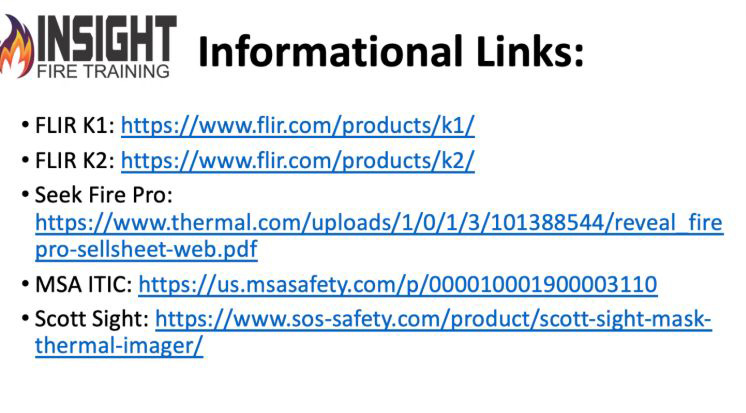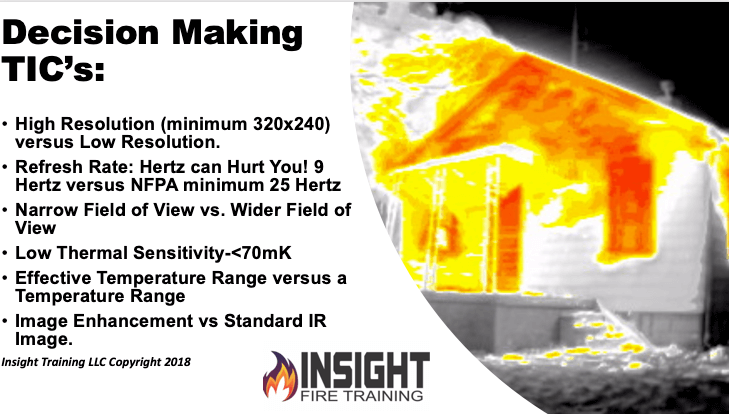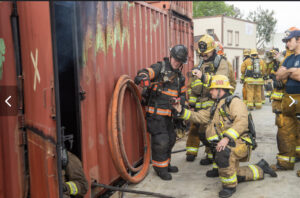Thermal Imaging Needs Assessment/Purchasing/Training Guidelines:

The following document was developed to assist departments with purchasing thermal imaging cameras and with their training needs. This document is the sole property of Insight Training LLC and is copyright protected. It may be used within the confines of the host organization but not for financial gain or instruction purposes without the written permission of Insight Training LLC.
I. Decide upon purchasing either a Situational Awareness TIC (mask mounted/SCBA mounted or small low cost/low resolution) or a Decision-Making TIC (High Resolution, High Dynamic Range, Fast Processor Speed, Multi-Application Use). You may read the full article here on this topic at our blog:
https://www.insighttrainingllc.com/2018/07/15/do-you-know-the-2-main- types-of-fire-service-tics/
All TIC’s are NOT the same. A lack of understanding of this statement can ultimately cost the department by an improper purchase and can lead to firefighter injuries or deaths.
This flawed thinking can be seen by failing to understand that there are predominately two major types of fire service TIC’s available today:

Seek Fire PRO 300 (2023):
• Situational Awareness TIC’s & Decision-Making TIC’s. Both are necessary and useful in their proper context but to use a situational awareness TIC for a decision-making TIC will ultimately lead the end user to a very dangerous and disappointing conclusion.
Please see this free webinar to explain the differences:
What is the difference between the two types of fire service TIC’s?
A situational awareness TIC can be simply described as a single purpose unit designed to prevent firefighter disorientation. They are generally smaller in size (can be hand-held, Facepiece mounted, or SCBA integrated). They are generally lower resolution and have a slower processor speed of refresh rate.
- Lower Resolution
- Slower Processor/Refresh Rate (9-16Hz).
- Used for locating the fire or locating their egress points.
A decision-making TIC can be described as one that meets the following criteria: High resolution (minimum of 320×240 pixels), Fast Refresh Rate (at least 25 Hertz), 3.5” viewfinder or display screen, and a High Dynamic Range (from zero degrees Fahrenheit to 1000 degrees Fahrenheit or up to 550 Degrees Celsius).

What does this mean to the end user or firefighter?
First, lower resolution fire service TIC’s have very short ranges of visibility and measurement (generally 7-10 feet or 2-4 meters). Secondly, they typically have a lower distance to spot ratio which means they are only able to accurately measure or determine a heat source at a relatively close distance such as 10 feet away. Thirdly, they tend to have a slower processor speed or refresh rate. Some are as low as 9 Hertz. One hertz is one frame per second. The human eye sees at 27 Hertz. Therefore, the NFPA 1801 minimum for refresh rate or processor is 25 Hertz.
Decision Making TIC’s:
- High Resolution (minimum 320×240) versus Low Resolution.
- Refresh Rate: Hertz can Hurt You! 9 Hertz versus NFPA minimum 25 Hertz
Narrow Field of View vs. Wider Field of View
Low Thermal Sensitivity-<70mK
Effective Temperature Range versus a Temperature Range
Image Enhancement vs Standard IR Image. Insight Training LLC Copyright 2018
Examples of Decision-Making Thermal Imaging Cameras
- FLIR K53-K65
- Bullard TXS, NXT or QXT
- Drager Fire Vista
- Leader 4.1
- Argus MI-TIC
- MSA 6000
- Seek Attack PRO
This is why we do not recommend purchasing a TIC less than 25-27 Hertz. TIC’s that have a refresh rate less than this rate tend to lag when scanning which can cause the end user to miss large areas as the TIC will shutter to catch up. As the TIC shutters or NUC’s (non-uniformity correction) it briefly closes its eyes by the process of an electronic shutter that fires in front of the lens allowing the pixels on the detector to be wiped clean and a new image is formed as the pixels receive new infrared heat signatures. The time it takes to perform this operation can cause firefighters to miss valuable information. For example, some situational awareness fire service TICs take 3-5 seconds when they encounter large heat signatures as the TIC switches from High Sensitivity to Low Sensitivity. In my tenure in the fire service, I have seldom encountered a patient firefighter in an environment where every second counts. This is why these lower refresh rates are not optimal nor practical for use as decision making TIC’s. However, it is recommended that firefighters do not take the performance specifications at face value alone. There are several 60 hertz Decision Making TICs that currently operate slower than some 25-30 hertz models due to their software enhancement programming.
But why would an organization or department try to use a situational awareness TIC improperly you might ask? Because they don’t know what they don’t know and for budgetary reasons. A smooth salesperson who shows them that they can buy a TIC for every firefighter for $1000 dollars versus the cost of one high- resolution decision-making TIC can be 5X’s this amount or higher can sway the buyer quite easily. We have read articles across the US and Canada where departments have gotten rid or disposed of their hand-held fire service TIC’s and replaced them with lower cost, low resolution, situational awareness TIC’s and have even made public statements that their firefighters are now better prepared. This is an illusion created by a lack of education and unethical salesmanship. Situational Awareness TIC’s are extremely important to firefighters and if a fire department can afford to outfit every firefighter with one, they will find that their firefighters will be safer. However, they are not meant nor designed to replace a high resolution, faster refresh rate, higher dynamic range decision making TIC.
Situational Awareness TIC’s are NOT used for:
- Exact Temperature Readings
- Size-up
- Search
- Directing Hose Streams
Situational Awareness TIC’s ARE used for:
• Staying Oriented
• Locating the Fire
• Locating other firefighters
• Locating Egress points
Step II: Decide Upon TIC’s Primary Purpose: Firefighting only or multiple applications such as: firefighting, hazardous material response, USAR, etc. TIC’s that are designed for other uses outside of standard fire & emergency response have different criteria that need to be considered.
First, consider NFPA 1801 Compliance. In the research paper “Maximizing Thermal Imaging Use in Emergency Service”, author & firefighter Michael Whitty sums it up well: “Fire departments that buy NFPA 1801 approved TIC’s will not be forced to go back and use the same model as previously purchased (and be trapped by replacement pricing an outdated technology) because the standard will mean their responders will be able to use a TIC from any manufacturer that meets the standard without retraining. This is a way of future proofing you’re training and TIC purchase” (Whitty, p.13).
Due to the constant demands upon fire department training divisions of constantly battling for enough time to maintain CEU’s, ISO hours, EMS training and more this certification allows one less training burden upon the department’s schedule.
A Decision-Making TIC that meets this certification will be easy to recognize.
It will have the following:
- A green power button.
- Universal Screen Symbols: (as shown in this adjacent photo)
- Four battery bars (each indicative of 25% power)
- TI Basic colorization
- Low Sensitivity Mode indicated by a green triangle in the upper left- hand corner (If equipped with this feature it shall have a green triangle within a green box that is displayed in the upper left-hand corner when this occurs). The Seek Thermal products use Mixed Gain mode and do not require an indicator as the pixels switch individually.
This standard also guarantees the following criteria are met for the department:
- High resolution-320 x 240 resolution
- Intrinsically Safe
- Durability: The TIC is placed through a series of demanding tests including flame contact, water immersion, and a 6’ drop onto concrete and the TIC must function properly after each test.
Resolution is one of the most important criteria for a Decision- Making TIC. There are currently many ranges of resolution available on the fire service market but the most commonly found are:
- 160 x 120: 19,200 pixels
- 320 x 240: 76,800 pixels
- 384 x 288: 110,582 pixels
- 640×480: 307,200 pixels
Each pixel is equivalent to a temperature measurement. Therefore, a higher resolution TIC (with more pixels) will produce a more detailed image, allow for
better decision making and see temperature progressions that could be missed with a lower resolution TIC. This could be the difference between missing a victim and saving one as shown in the comparison between a low- resolution TIC and a high-resolution TIC. For example, a firefighter equipped with a 160 x 120 resolution TIC can effectively discern a small child’s hand at 7 feet away whereas a firefighter with a high- resolution TIC (384 x 288) can effectively discern a small child’s hand up to 20 feet away.
Thus far, we covered three out of the five minimum criteria for a department purchasing a Decision-Making TIC. Thermal imaging allows firefighters to make more informed decisions if they are trained properly. A Decision-Making TIC with a low thermal sensitivity (this is rated in units of millikelvin) will allow the user to discern smaller details in uniform temperatures.
Why is this important?
Because TIC’s display images based on temperature differences. If there is a uniform temperature environment within the firefighter’s field of view the TIC is essentially blind. Many fire service TIC’s have very low thermal sensitivity or minimum resolvable temperature difference ratings (MRTD). These lower ratings allow the TIC to see fractions of a degree. In layman’s terms the lower the number, the more defined the image will be. These numbers are usually found in mK (thousandths of a degree). As the image above illustrates (courtesy of Max Fire Box) a higher sensitivity (lower MRTD) allows a firefighter to be easily viewed in this image.
Warning!
• Don’t use outdated technology with modern concepts and expect top notch results. You will be disappointed, injured, or worse!
Thermal Sensitivity in Decision Making TIC’s
- Argus: Low Sensitivity<70mK
- Bullard: Low Sensitivity <30 mK
- Drager: Low Sensitivity <50 mK
- FLIR: Low Sensitivity <30 mK
- Leader: Low Sensitivity <50mK
- MSA: Low Sensitivity <234 mK
- Scott X380 Low Sensitivity <50mK
- Seek Attack PRO <35mK


All of these criteria for a Decision-Making TIC hinge upon the least understood criteria which is commonly called Processor Speed, or Refresh Rate. It is extremely important that any fire department purchasing a TIC understand that the minimum frequency they should purchase is 25 Hz.
Why is this important?
Because many thermal imaging cameras are available at 9 Hz due to an international trade law that prevents the ‘bad guys’ from buying Infrared Cameras at the sporting goods store. The human eye sees at 27 Hz and our TV’s in our home’s display images at a minimum of 30 Hz. Why? Because 1 Hz is one cycle per second and anything less than what the human eye sees will produce a lag. This dramatically slows down the efficiency and effectiveness of the firefighter using the device.
A firefighter who scans a room left to right will find that a 9 Hz TIC’s image will “freeze” for a long duration allowing the processor to catch up. In other words, it cannot process the Infrared Radiation fast enough to keep up with the demands and speed of the firefighter. In regard to Decision Making TIC’s, most of the one’s available today are 60 Hz which are very fast thereby producing an almost continuous display of information.
NFPA 1801 compliance: There are only a few NFPA 1801 (2018 edition) compliant decision-making cameras currently available. They are as follows: FLIR K65, Bullard NXT, Argus MI-TIC, Seek Attack PRO+ And MSA 6000. If you wish to see this list in detail, you may view it in its entirety at:
https://www.seinet.org/search.htm#§ion=hidden- fire_and_emergency_services,hidden-thermal_imaging_cameras,hidden-84- 4345,hidden-84_206-4345
In summary, an organization looking to purchase a thermal imaging camera must first decide on whether they are purchasing a Situational Awareness TIC or a Decision-Making TIC. Once this is completed, they must decide on its overall use. If it is for any purpose outside of firefighting, special criteria must be considered that are not mentioned in this article.
For further information on this subject please check out the resources listed in the works cited section (specifically pages 12-20 in the Maximizing Thermal Imaging Use in the Emergency Services by Michael Whitty). Once the criterion for the selection is reviewed, the organization would do well to review the wealth of manufacturer literature online on the TIC’s they wish to test. Once they are well informed, they can make a better decision about their purchase. They should not purchase a TIC based on its performance on the sales floor. The TIC selected should be tested in live fire evolutions and compared to the other devices.
A Fire Department should pick their top three cameras based on the aforementioned criteria and then test them in a live fire environment. The parameters on how it should be tested can be found in our Thermal Imaging Purchasing & Implementation Criteria Course. For the cost of one thermal imaging camera, a department can learn how to buy & apply what they need and “future-proof” their decision-making abilities from salesmanship and low quality/outdated thermal imaging cameras that will ultimately not fit their needs.
Please see the questions at the end of this document for further assistance. We can provide this service to you in the following formats: online, classroom, classroom/hybrid, and classroom/live fire single day training sessions.
Andy J. Starnes
Level II Thermography Certified
Insight Training LLC
andystarnes@instructorandystarnes.com
YouTube: InsightTrainingLLC
Facebook: Insight Fire Training
Linkedin: Andy Starnes or Insight Training LLC
Instagram: @InsightTrnLLC
X/Twitter: @InsightTrn
Thermal Imaging Needs Assessment: From Purchasing, Planning, to Providing Training:
Step 1: Decide upon the type of TIC: Situational Awareness vs. Decision Making TIC:
Step 2: Type of Use: Specific Use vs. Multi-purpose?
Will it be used strictly on the fire ground or for other uses such as searching for lost persons, Haz-material incidents, USAR, etc.?
Multi-purpose or Multi-application TIC’s require greater amounts of training to ensure proper interpretation. When choosing a TIC, be aware if all of the options that it may offer may not be in your organizations best interest.
One Button Models: Firefighters make split second decisions with little time to adjust in a dynamic environment. Thermal Imaging Camera’s with several buttons and several application modes can confuse or cause problems when inside a fire environment.
Step 3: Needs Assessment? Budget, number of tics, training:
A) How many Thermal Imaging Cameras do you plan to purchase or currently have? And what brand and models are they?
B) What amount of training do you plan to invest/implement to maintain the knowledge firefighters will gain from this training?
C) What is your current level of training and education with Thermal Imaging?
- D) How does your organization currently use Thermal Imaging Cameras? For Search & Overhaul only or Tactically?
- E) What is your organization staffing model for a structure fire? (4 on an Engine company etc?) and which person on the company carries the TIC?
- F) What is the current TPP (Thermal Protective Performance) of your organizations PPE
Step 4: Do the TIC’s you have chosen meet the following criteria:
- At least 25 Hz refresh rate:
- High Resolution: Minimum of 320×240 or 76,800 pixels
- Low Thermal Sensitivity: Less than 70 Mk (this allows for greater contrast in uniform temperature environments which allow firefighters to locate downed firefighters or victims faster).
- Is it NFPA 1801 Approved or meet the spec? By purchasing NFPA 1801approved TIC’s an organization is future proofing their training due to the interoperability requirement of NFPA 1801. Every TIC that meets this standard will have the same power button, the same screen symbols, and same color palette (TI Basic). Therefore, if an organization chooses to change TIC Manufacturer brands when they make their next purchase as long as they purchase an NFPA 1801 approved TIC they do not need to retrain their firefighters on how to operate the TIC.
- Ergonomics: weight, easy to use etc.? Firefighters carry a tremendous amount of heavy PPE, tools, and equipment. The last thing they want to be told is that they will be carrying another item that is heavy or hard to use due to poor design. Ensure that the firefighters not only know how to use the TIC but be certain to gain their approval on whether or not the TIC is easy for them to carry and is lightweight.
Step 5: Test your top 3 picks in live fire! No exceptions! The TIC’s need to be tested in the following: Field of View, Temperature Modes, Application Modes, Ease of Interpretation, Thermal Sensitivity, and Emissivity Demonstration.
Step 6: Warranty & Service: Who is going to help you when you have a problem? How long will it take to get it fixed? Do you know how to take care of them to make your investment last? Does your budget include purchasing new batteries for the TiC every two years?
Step 7: Replacement Strategy: When will you buy new ones? Whats your strategy? Has your department budgeted to replace these as they become outdated?
Step 8: Make a decision.
